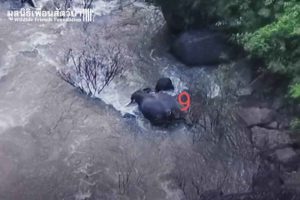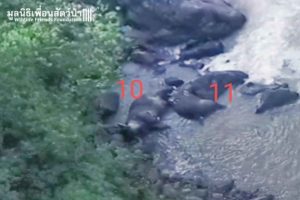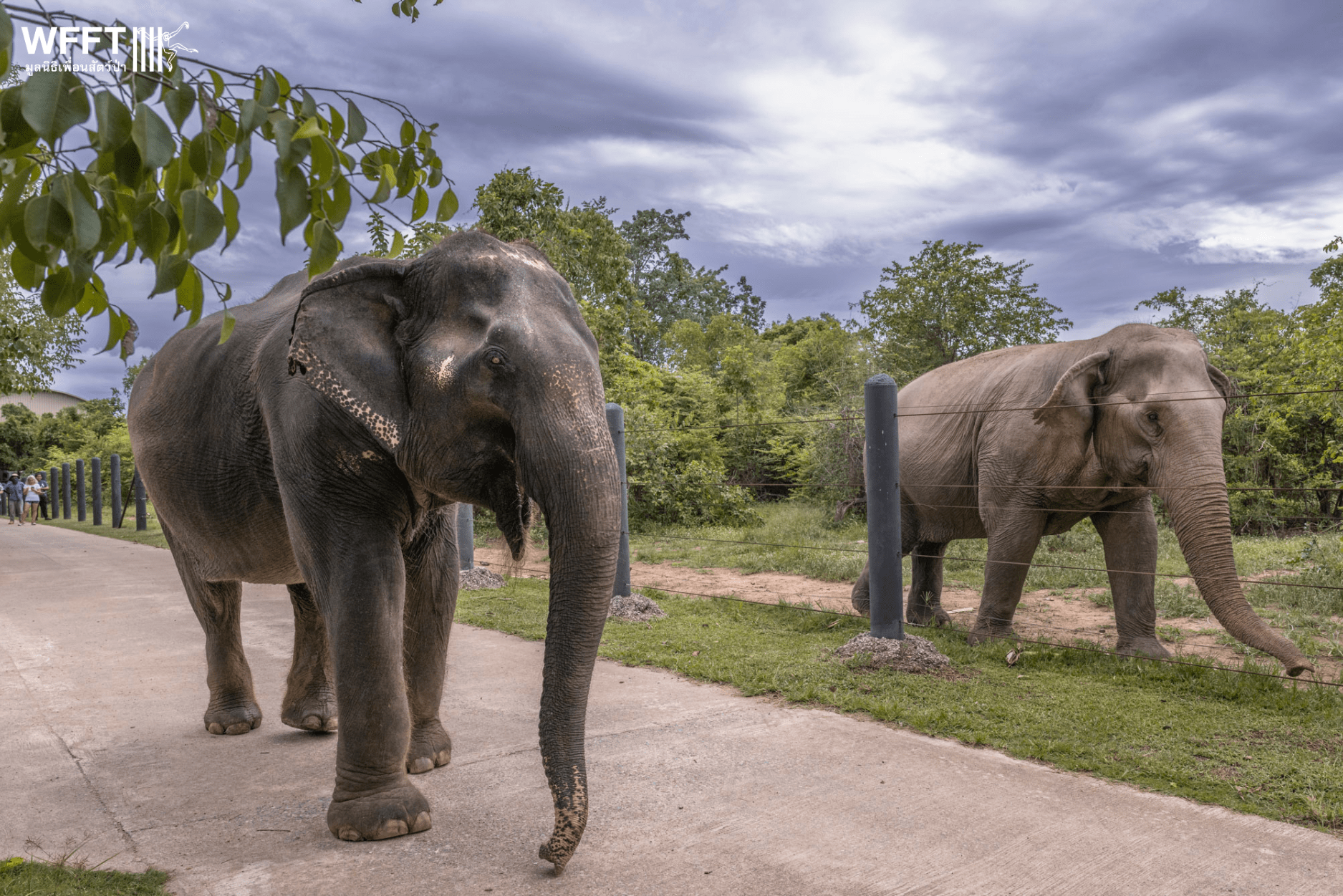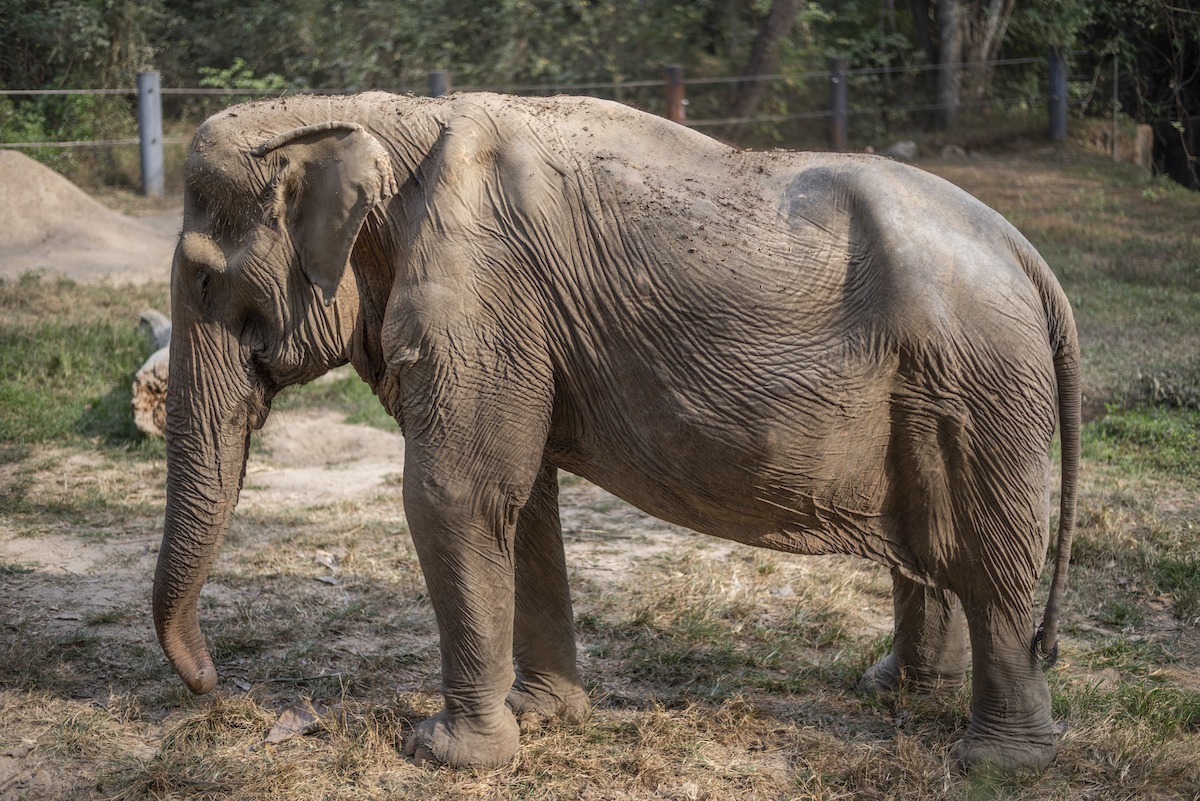Hope for Alicia regaining some sight following a specialist visit.
Elephant Herds Increasing Despite Thai Tragedy
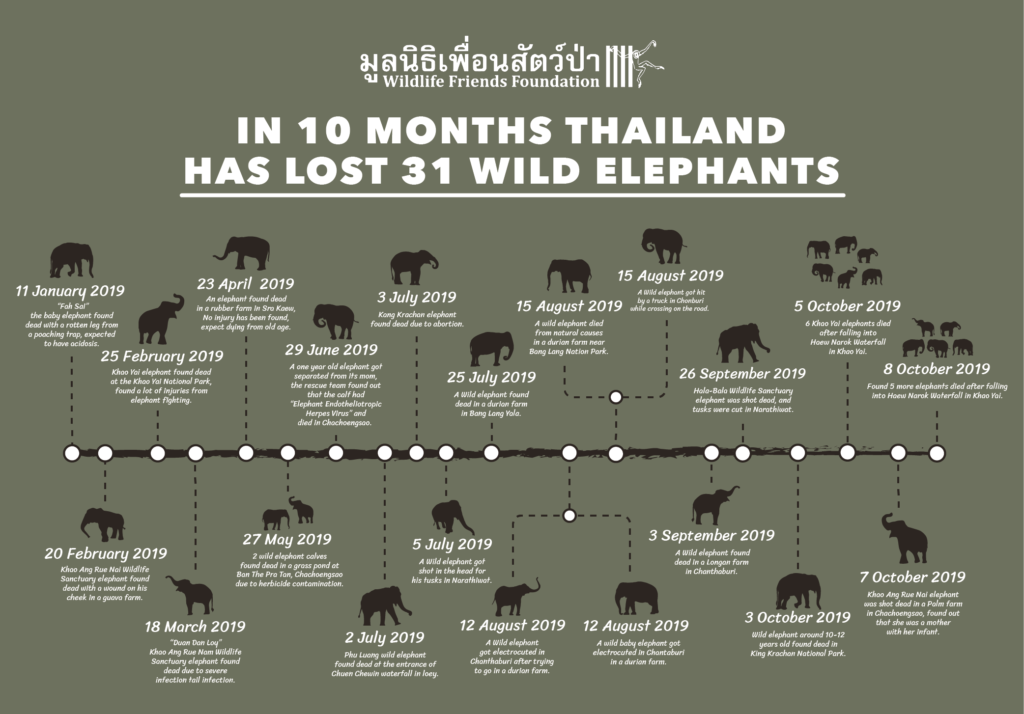
(Scroll down for Thai)
Plans to protect elephants should focus on protecting habitat, curbing conflict with humans and proper punishment of poachers. Rangers at Khao Yai National Park in central Thailand heard the trumpeting of distressed elephants several hours before dawn on Saturday October 5.
Officials from the Department of National Parks discovered the cause of their misery later that morning, when they found the carcasses of six wild elephants at the Haew Narok Waterfall. A few days later, five more dead elephants were found, drowned on a lower step of the waterfall after drones were used to check around the area for more surviving members of the herd. These animals are suspected to have died while trying to save other younger members of the herd that got into trouble.
This sad and unusual tragedy at Khao Yai, 120 kilometers northeast of Bangkok, has attracted worldwide media coverage and been the subject of much discussion on social media. Many people have blamed the authorities for the elephants’ deaths, saying they should have set up a fence or a wall to stop the elephants from falling in to the waterfall or for not having an easy way out from the water.
In our view, as a wildlife conservation group, we believe that humans should interfere as little as possible with natural areas and that we should encourage wild areas to remain just as nature and evolution created them.
Building walls around a waterfall would interfere with the movement of not just elephants but might have a negative impact on other wild species living in the national park. And a small group of elephants would probably destroy any kind of fencing within months – these animals have an average weight of 3,500 kilograms (3.5 tons). One would need to erect massive structures in an area that is beyond the reach of large equipment. And building any kind of road to this area would only create further problems in a park that is already highly disturbed by an overload of tourists.
Some reports and comments posted online have been misleading. Claims that the 11 dead elephants were some of the “last remaining elephants in Thailand” are far from the truth. The country has, in fact, seen an increase in the wild population of elephants over the last 15 to 20 years. Indeed, that rise has resulted in new problems that may actually be a bigger threat to this majestic species, which most Thais revere and which is the national symbol of Thailand.
Since the beginning of this year, at least 31 elephants have been found dead in different parts of the country. That figure includes the 11 at the Haew Narok (Hell’s Fall) Waterfall.
Many of the others were found outside their natural habitat, in orchards and farm areas, while some were killed by cars speeding through forest areas that are their home. A few also were killed by poachers for their ivory.
(scroll down to continue reading the full story)
Records of elephants dying deep in the jungle are rarely reported as their bodies are naturally disposed of within a few weeks; nature does take care of itself. Our aim should not be to build fences inside a jungle to save a few, rather we should focus on the bigger picture and greater causes for concern – the poaching of elephants for illegal trade, the human-elephant conflict occurring in areas countrywide and the safety of both people and wildlife when we decide to build and use roads through wildlife areas.
The number of elephants killed in areas of conflict has been rising every year since 2012 and not enough is done to turn this issue around. Elephants are still losing habitat and in many cases the patches they have lost were connected to areas where they used to forage for food and met up with other herds.
More importantly, these areas were supposed to be natural corridors for male elephants moving to other herds and habitat. But many of these males now wander around agricultural areas, pushed out from their original herds as they mature and are unable to reach a new herd and habitat.
In some areas, north of Khao Yai, for example, small groups of up to six males create havoc for villagers on a daily – or rather nightly – basis, because they are not able to move back to their original habitat, or to reach a new natural home.
Elephants have sometimes been driven out of their long-term natural habitat by farmers who have decided to raise cattle in forests. And in some areas, even tourism is a serious threat to wild elephant herds, which makes them want to move out. The problem of elephants coming out of a forest is way more complex than a lack of food or water for them.
New wildlife law
With the new Wildlife Preservation Act (2019) coming into law next month we see potentially higher fines – of up to 1 million baht – and jail terms up from two to 10 years for the poaching or illegal trade in wild elephants. Syndicates and influential figures involved in the illegal trade in wildlife can face prosecution like drug dealers, so that any wealth they gained from illegal businesses can be confiscated.
The question that remains, however, is how far enforcement agencies will go to uphold the law. The 1992 Wildlife Preservation Act, which has been the country’s main wildlife law up to now, was in principle not a bad law. But has rarely been enforced to its maximum capacity, in my humble opinion. If enforced properly, the new law could have a positive impact to prevent the killing of elephants for trade.
If we want to see a decrease in the number of wild elephants dying, we need to act now. With a rising population of elephants in the wild in Thailand and little chance of creating more habitat for them, we will need an action plan to create more wildlife corridors and to ensure that some areas are completely reserved for wild animals. Having areas where elephants won’t be disturbed by humans would at least lessen the pressure and need for elephants to come out of the forests.
But we also need to think beyond Thailand’s borders.
Most of this country’s neighbors have far fewer elephants in the wild, so we would need to turn that problem into an opportunity. If neighboring states can enforce anti-poaching and wildlife protection laws in the future, we could relocate some of Thailand’s elephants to protected areas in, for example, Cambodia, Vietnam or Laos.
But, if we do nothing now the conflict will only worsen, as spaying (neutering) of elephants is tricky and questionable, and culling is not an option in Thai or Buddhist culture.
Edwin Wiek is the head of Wildlife Friends Foundation of Thailand (WFFT), a non-government group based in Phetchaburi. He has worked on wildlife conservation in Thailand for more than two decades and was recently an adviser for the government on its new legislation.
This story is also published at https://bit.ly/2M7EF6Y
เหตุการณ์โขลงช้างป่าเขาใหญ่ 11 ตัว ที่พลัดตกน้ำตกเหวนรก นับว่าเป็นความสูญเสียช้างป่ามากที่สุดในประวัติศาสตร์
โดยเริ่มจากช้างป่า 6 ตัว ที่ยืนยันการพบซาก เมื่อวันที่ 5 ตุลาคมที่ผ่านมา แต่หลังจากมีการบินโดรนสำรวจทางเจ้าหน้าที่ได้แถลงข่าวเมื่อ วันที่ 8 ตุลาคม ว่าพบซากช้างเพิ่มอีก 5 ตัว ทำให้พบซากช้างทั้งหมด 11 ตัว ลอยกระจายกันไปตามธารน้ำตก ในส่วนของช้างแม่ลูกที่รอดชีวิตมีการยืนยันพบเห็นกลับเข้ามาหากินในบริเวณลานจอดรถน้ำตกเหวนรก ซึ่งในขณะนี้เจ้าหน้าที่ทุกภาคส่วนยังอยู่ระหว่างการเก็บกู้ซากช้างป่า เจ้าหน้าที่ได้ลำเลียงอุปกรณ์ทั้งเชือก ทุ่น อวน ร่วมติดตั้งตาข่ายเพื่อเตรียมดักซากช้าง ตั้งแต่ครั้งแรกที่มีการบันทึกข้อมูลไว้ในปี 2529 จนถึงปัจจุบัน มีช้างป่าพลักตกจากนำตกเหวนรกรวมทั้งสิ้น 31 ตัว
ช้างเป็นสัตว์ครอบครัว เมื่อช้างในโขลงได้รับอันตราย ช้างตัวอื่นๆ จะรีบรุดเข้าช่วยเหลือ จากเหตุการณ์ที่เกิดขึ้นไม่มีใคร หรือเจ้าหน้าที่คนไหน อยากให้เหตุการณ์แบบนี้เกิดขึ้น ภัยทางธรรมชาติในช่วงหน้าน้ำหลากเมื่อช้างไม่สามารถคาดคะแนความเชี่ยวของน้ำได้ จึงพากันตกน้ำ ทางมูลนิธิ ฯ จึงเห็นว่าเราไม่ควรเข้าไปจัดการกับธรรมชาติมากจนเกินไปนัก ทั้งนีทั้งนั้น กรมอุทยานแห่งชาติ สัตว์ป่า และพันธุ์พืช วางแผนมาตรการแนวทางป้องกันโดยการซ่อมแซมเพนียดกั้นช้าง เพื่อไม่ให้ช้างเดินเข้าไปบริเวณหน้าผา และเตรียมติดตั้งอุปกรณ์เซ็นเซอร์สำหรับตรวจจับสัตว์ป่า ไว้ที่บริเวณแนวรั้วกั้นช้างตก
แต่นี่ไม่ใช่สาเหตุทางธรรมชาติเพียงอย่างเดียวที่ทำให้มีการสูญเสียเกิดขึ้น ในขณะเดียวกันยังมีอีกหลายเหตุการณ์ ทั้งที่เป็นข่าวหรือที่ไม่ถูกเปิดเผย มูลนิธิเพื่อนสัตว์ป่าได้รวบรวมเหตุการณ์การสูญเสียชีวิตช้างป่าในเขตพื้นที่ต่างๆ ในประเทศไทย ภายในปี 2562 ตั้งแต่เดือน มกราคม จนถึง ตุลาคม
การสูญเสียล้วนเกิดมาจากหลายหลายสาเหตุ ทั้งความขัดแย้งระหว่างช้างป่าและมนุษย์ เนื่องจากช้างป่าเข้าไปบุกรุกไร่สวนของชาวบ้าน หรืออีกนัยหนึ่งคือพื้นที่ป่าของสัตว์ค่อยๆ ถูกเปลี่ยนให้เป็นแหล่งเกษตรกรรมของมนุษย์ ทำให้ช้างค่อยๆ ขาดแคลนแหล่งน้ำแหล่งอาหาร ชาวบ้านจึงใช้วิธีกั้นรั้วไฟฟ้ากันช้างเข้ามาในสวนเป็นสาเหตุให้ช้างถูกไฟช็อตตาย หรือการฆ่าช้างเพื่อป้องกันตนเองเมื่อถูกช้างบุกรุก อุบัติเหตุรถชนช้างโดยเฉพาะถนนที่ตัดผ่านอุทยานแห่งชาติต่างๆ ซึ่งเป็นแหล่งอาศัยของช้าง การลักลอบฆ่าช้างเพื่อเอางา เอาหนัง ไปขายยังตลาดมืดเพราะมีความเชื่อว่างาช่วยเสริมบารมี และหนังใช้กินเป็นยารักษาโรคต่าง ๆ
อาชญากรรมต่อสัตว์และสิ่งแวดล้อมเหล่านี้จำเป็นที่จะต้องมีมาตรการแก้ไขจากทุกภาคส่วน และรัฐบาลควรจะนำปัญหาช้างป่าเข้าสู่การแก้ไขโดยด่วน รวมถึงการลงโทษผู้กระทำความผิดควรเป็นไปอย่างเหมาะสม เพื่อให้ครอบคลุมถึงสิทธิสัตว์และความปลอดภัยของมนุษย์ไปพร้อมกัน ลดความสูญเสีย และสร้างความสมดุลของทั้งคนและช้างให้มากที่สุด





